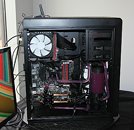- Joined
- Oct 9, 2007
- Messages
- 47,635 (7.44/day)
- Location
- Dublin, Ireland
| System Name | RBMK-1000 |
|---|---|
| Processor | AMD Ryzen 7 5700G |
| Motherboard | Gigabyte B550 AORUS Elite V2 |
| Cooling | DeepCool Gammax L240 V2 |
| Memory | 2x 16GB DDR4-3200 |
| Video Card(s) | Galax RTX 4070 Ti EX |
| Storage | Samsung 990 1TB |
| Display(s) | BenQ 1440p 60 Hz 27-inch |
| Case | Corsair Carbide 100R |
| Audio Device(s) | ASUS SupremeFX S1220A |
| Power Supply | Cooler Master MWE Gold 650W |
| Mouse | ASUS ROG Strix Impact |
| Keyboard | Gamdias Hermes E2 |
| Software | Windows 11 Pro |
Phanteks' highly desirable dual-motherboard case, the Enthoo Mini XL, was displayed with a new PSU power splitter accessory, at Computex. Simply put, this accessory lets you multiply the 24-pin ATX and 8-pin EPS connectors of your PSU, so you can run both the ATX and ITX motherboards with a single PSU, with the added freedom of shutting down and powering up either board without affecting the other. The splitter takes is 'smart' in this way. It takes 24-pin and 8-pin inputs from the real PSU, and to the end user, behaves like two PSUs, so both "systems" (motherboards) can be turned on or off at whim.


View at TechPowerUp Main Site


View at TechPowerUp Main Site




